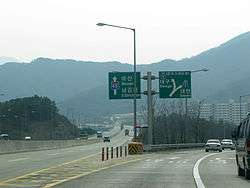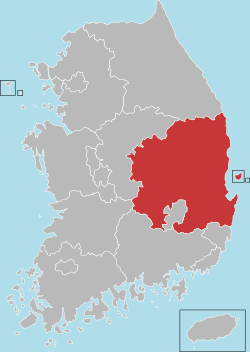Gimcheon
| Gimcheon 김천시 | ||
|---|---|---|
| Municipal City | ||
| Korean transcription(s) | ||
| • Hangul | 김천시 | |
| • Hanja | 金泉市 | |
| • Revised Romanization | Gimcheon-si | |
| • McCune-Reischauer | Kimch'ŏn-si | |
 | ||
| ||
 Location in South Korea | ||
| Country |
| |
| Region | Yeongnam | |
| Administrative divisions | 1 eup, 14 myeon, 7 dong | |
| Area | ||
| • Total | 1,009.5 km2 (389.8 sq mi) | |
| Population | ||
| • Total | 150,000 | |
| • Density | 150/km2 (400/sq mi) | |
| • Dialect | Gyeongsang | |
Gimcheon (김천; 金泉市; trans., 'gold spring city') is a city in North Gyeongsang Province, South Korea. It is situated on the major land transportation routes between Seoul and Busan, namely the Gyeongbu Expressway and Gyeongbu Line railway.
In ancient times, Gimcheon was famous for its three mountains (Geumo, Daedeok, Hwangak) and two rivers (Gamcheon, Jikjicheon). During the Chosun Dynasty, Gimcheon had one out five largest markets in the region. The town has also served as the gateway and traffic hub of the Yeongnam region and is particularly proud of its patriots, history and conservative lifestyle.
The city brand slogan of Gimcheon city is 'Central Gimcheon', a recognition of the fact that it is situated almost at the center of Korea.
Symbols of the city:
- Bird – Common Heron. The birds build nests in tall trees and breed from April through July.
- Flower – Plum Flower. Dicotyledonous plant, deciduous tree of the rose order and family.
- Tree – Pine. Gymnosperm, strobilaceous evergreen, acicular tree of the pine tree family.
History
- Samhan Period : called Gammun-guk, Jujoma-guk
- Three kingdoms : Silla united Gammun-guk and Jujoma-guk and established Gammunju
- Unified Silla : Gammunju was renamed as Gaeryeonggun. Gimsanhyeon, Jiryehyeon, Eomohyeon and Mupunghyeon were placed.
- Goryeo Period : Gaeryeonggun was changed into Gaeryeonghyeon. Gimsanhyeon and Jiryehyeon were included into Gyeongsanbu.
- Joseon Period Gimsanhyeon and Eomohyeon were united into Gimsangun.Jiryehyeon was promoted to Jiryegun and Gaeryeonghyeon to Gaeryeonggun.
- 1914 Gimsan, Jirye (except Gilbangri Jeungsanmyeon), Gaeryeonggun and Singokmyeon of Seongju were united into Gimcheongun(20myeons).
- 1917 : Gimcheonmyeon was promoted to Gimcheon special myeon.
- 1931 : Gimcheon special myeon was promoted to Gimcheoneup ( 1eup, 15 myeons).
- 1949 : Gimcheoneup was promoted to Gimcheon city, Gimcheongun wa renamed geumneunggun.
- 1983 : 4 ris of Geumneunggun were included into Gimcheon city. 2 ris of geumneunggun were included into Seonsangun.
- 1998 : arrangement of 13-dongs in Gimcheon city into 9-dongs (1-eup, 14-myeons, 9-dongs), arrangement of 9-dongs in Gimcheon city into 8-dongs (1-eup, 14-myeons, 8-dongs).
Culture & Sightseeing
Sights
Gimcheon's claim to fame is Jikjisa Temple (직지사), located at the foot of Mt. Hwangaksan. The temple was constructed in 418 (the 2nd year of King Nulji's reign, Silla Dynasty). Jikjisa is an important head temple of the Jogye Order of Korean Buddhism. This temple is in perfect harmony with the nearby valley and pine forest. The foliage in fall is particularly breathtaking. It features Birojeon Hall (also known as ‘Cheonbuljeon Hall’), in which approximately 1,000 Buddha statues are enshrined, along with a thousand year old arrowroot. Iljumun Gate, Daeungjeon Hall (one of the most famous architectural structures of the Joseon Dynasty) and a 1.63m-tall Seated Stone Buddhist Statue (Treasures No. 319) from the Unified Silla Period, can also be found on the temple grounds.
Jikjisa is believed to have been first constructed by the Goguryeo monk Ado in the year 418, long before Buddhism gained general acceptance in Silla. Jikjisa was largely destroyed during the Seven Year War in the 1590s. The reconstruction of the temple spanned from 1610 to about 1670.
Jikjisa is possibly one of the oldest temples in South Korea and it is relatively well-connected to a convenient train and bus service. Jikjisa Station is located at the foot of the mountain, along the Gyeongbu Line railroad. It is served only by local commuter trains, which run twice daily in each direction. Overnight or weekend temple stay programs are available at the main complex.
Temple Admission Fees: Adults: 2,500 won Youth: 1,500 won Children: 1,000 won *Free: ages under 6 and over 65
Directions to Jikjisa: - Dong Seoul Terminal to Gimcheon (Departure 3 times a day (10:10, 14:10, 18:10), 3 hour ride). - Get on the bus (No. 11, No. 111) to Jikjisa Temple at Gimcheon Station or Gimcheon Bus Terminal(25 minute ride).
Hiking & Mountains
Mt. Hwangaksan (1,111m in elevation), home of Jikjisa, is located in the Sobaeksan Mountains. The area is a well known habitat for many cranes that reside on this mountain. This location is also famous for its thick pine forests, pristine streams, beautiful fall foliage and splendid snowscapes.
Other Natural & Outdoor Cultural Properties:
- Sudo Valley
- Yongo Waterfall
- Yetnalsomssimaeul Culture Village
- Sculpture Park
- Riverside Park
- Yeonhwaji Pond
Festivals
- Grape Sale Promotional Event
Various events including a beauty pageant, a grape fair, sales and food fair introducing various grape foods are offered every July in the downtown area.
- Half-Marathon Race
An annual sporting event held at the Sport City every May. Traditional military band performances and ballroom dancing are also offered, in addition to various food events.
- Family Drama Festival
An annual festival at the Gimcheon Art Hall every October emphasizing the importance of family through plays and dramatic performances.
Museums
- Bitnae Nong-ak Training Center
- World Ceramic Museum
Temples & Cultural Sites
- Cheongamsa Temple
- Sudoam Temple
- Gyerimsa Temple
- Gaenyeong Hyangyo Confucian School
- Jirye Hanggyo Confucian School
- Hahoe House of the Seongsan Yeo Family
- Seated Buddha Statue, Gahangsa Temple
- Bangchojeong Pavilion
Other Places of Interest
- Baegsu Literature Hall
- Culture & Art Hall
- Gimcheon Municipal Library
- Citizen's Bell
- Obong Reservoir
- Sports City
- Gimcheon University
Shopping & Restaurants
Gimcheon's dining options mainly consist of the average Korean, Japanese, and Chinese restaurants that are found in abundance throughout Korea. The majority of the city's restaurants are locally owned but some major chains can also be found, including more popular or Western-friendly choices.
Traditional Food
Traditional restaurants can be found in almost all of Gimcheon's districts but the largest concentration of such establishments is located at the base of Jikjisa Temple, in the Jikji Culture Park. The Culture Park features an ample selection of both local and traditional specialities.
Fast Food & Chain Stores
- Kyochon Chicken
- Lotteria
- McDonald's
- Domino's Pizza
- Pizza Hut
- Pizza School
- Juk Story
- Paris Baguette
- Dunkin Donuts
- Han's Deli
- Tous Les Jours Bakery
- Yoger Presso Coffee
- Pasta Buono
- Angle-in-us
- Café Bene
Expat & Western Dining
The Lucky Penny is a locally owned restaurant in the Bugok-dong neighborhood. The menu includes Western and American favorites such as hamburgers, quesadillas, Philly cheesesteak sandwiches and other popular dishes. Jared Sandler, Professor of English at Gimcheon University, is a regular visitor to the Lucky Penny. He gained the status of "#1 Customer" after donating a television that hangs on the wall to this very day. [2]
Shopping
Downtown Gimcheon, centered around the train station, consists of the largest selection of shopping in town. In the middle of town there is a popular five-day market held on days ending in 0 and 5. Most days, though, there quite a few vendors in the area and the two largest traditional markets in town are always open for business.
Major Stores include:
- Food/Groceries - EMart, Lotte Mart, Hanaro Mart, Power Mart
- Cafés - Sleepless in Seattle, Paris Baguette, Natuur, Cafe Bene, Angel-in-Us Coffee
- Cosmetics - Skin Food, Etude House, Innisfree, Tony Moly, The Face Shop, Missha
- Clothing - The North Face, Bean Pole, Adidas, Olivia Hassler, Solb Lingerie, Nike
- Convenience Stores - 7 Eleven, Family Mart, CU, GS25
- Electronic Goods - Samsung, LG
- Cellular Service Providers - Olleh
- Home Goods - Daiso (2 locations)
Being a smaller town, Gimcheon does lack certain amenities such as large department stores. The closest locations for larger stores is the city of Gumi, located roughly 20 minutes away by train, where shops such as Lotte Mart and Homeplus can easily be found.
Banking & Financial Services
Available financial institutions in Gimcheon include:
- Nong-Hyup Local Cooperative (NH Bank)
- KB
- Shinhan
- Industrial Bank of Korea (IBK)
NOTE: English speaking staff are only found at the largest banks or headquarter centers.
Transportation
Road
Gimcheon is located along the Gyeongbu Expressway and many major roadways connect the city to other surrounding areas.
Rail
Main transportation connections are via the Gyeongbu Line and the Gyeongbuk Line train lines. In 2010, a newly constructed KTX station, Gimcheon-Gumi Station opened on the outskirts of the city center The district around this new KTX station is slowly expanding, however, currently it is only accessible by vehicle, local bus or taxi. From the KTX station to Gimcheon Train Station (the main downtown shopping center) via taxi, it is roughly a 15,000 to 20,000₩ expense.[3]
Distance to other destinations:
- Gumi City - 20 minutes by train
- Daegu - 45 minutes by train
- Daejeon - 50 minutes by train
- Busan - 2 hours, 50 minutes by train / 1 hours, 15 minutes by KTX
- Seoul - 3 hours by train / 1 hour, 30 minutes by KTX
NOTE: The times listed are rough estimations solely meant to provide a general idea. For specific times, contact the Korail train services for more information.
Community & Expat Information
In 2004, it was reported that the population was 144,587, including 143,527 Koreans and 1,060 non-Koreans.
While Gimcheon is much smaller compared to its nearby counterparts, there is a sizeable expat community scattered amongst the seven district neighborhoods. As of 2013, there are an estimated 40 to 60 expats residing within the city limits, most employed as English teachers through the government run EPIK (English Program in Korea) and TaLK programs.
Local Specialties
- Grapes - Gimcheon is responsible for 11% of total grape production in Korea.
- Plums - 29% of the total plum production in Korea stems from Gimcheon. They are high in vitamin A and known for aiding with fatigue.
- Gwahaju - Literally named "post-summer wine", this local drink is made from glutinous rice and yeast. Fresh water for production is sourced from Gimcheon's Gwahacheon Stream.
- Jirye Wild Boar Meat - Said to be especially beneficial for young children due to a high concentration of protein, healthy fats and DHA.
- Brassware and gong production.
- Joma Potatoes
Administrative Districts
The outlying regions of Gimcheon are divided into fourteen myeon (or townships) and one eup (or large village). In addition, the city center is divided into seven dong, or precincts.
- Apo-eup
- Bongsan-myeon
- Buhang-myeon
- Daedeok-myeon
- Daehang-myeon
- Eomo-myeon
- Gamcheon-myeon
- Gammun-myeon
- Gaeryeong-myeon
- Guseong-myeon
- Jirye-myeon
- Joma-myeon
- Jeungsan-myeon
- Nam-myeon
- Nongso-myeon
- Bugok-dong
- Daesin-dong
- Jijwa-dong
- Pyeonghwa-dong
- Seongam-dong
- Yanggeum-dong
- Yongam-dong
Sister Cities
See also
References
- ↑ Official page of Gimchon(eng) http://www.gimcheon.go.kr/
- ↑ the opinion of Eric Spence
- ↑ Gimpo city homepage(Kor)
External links
| Wikimedia Commons has media related to Gimcheon. |
Coordinates: 36°08′N 128°06′E / 36.133°N 128.100°E

